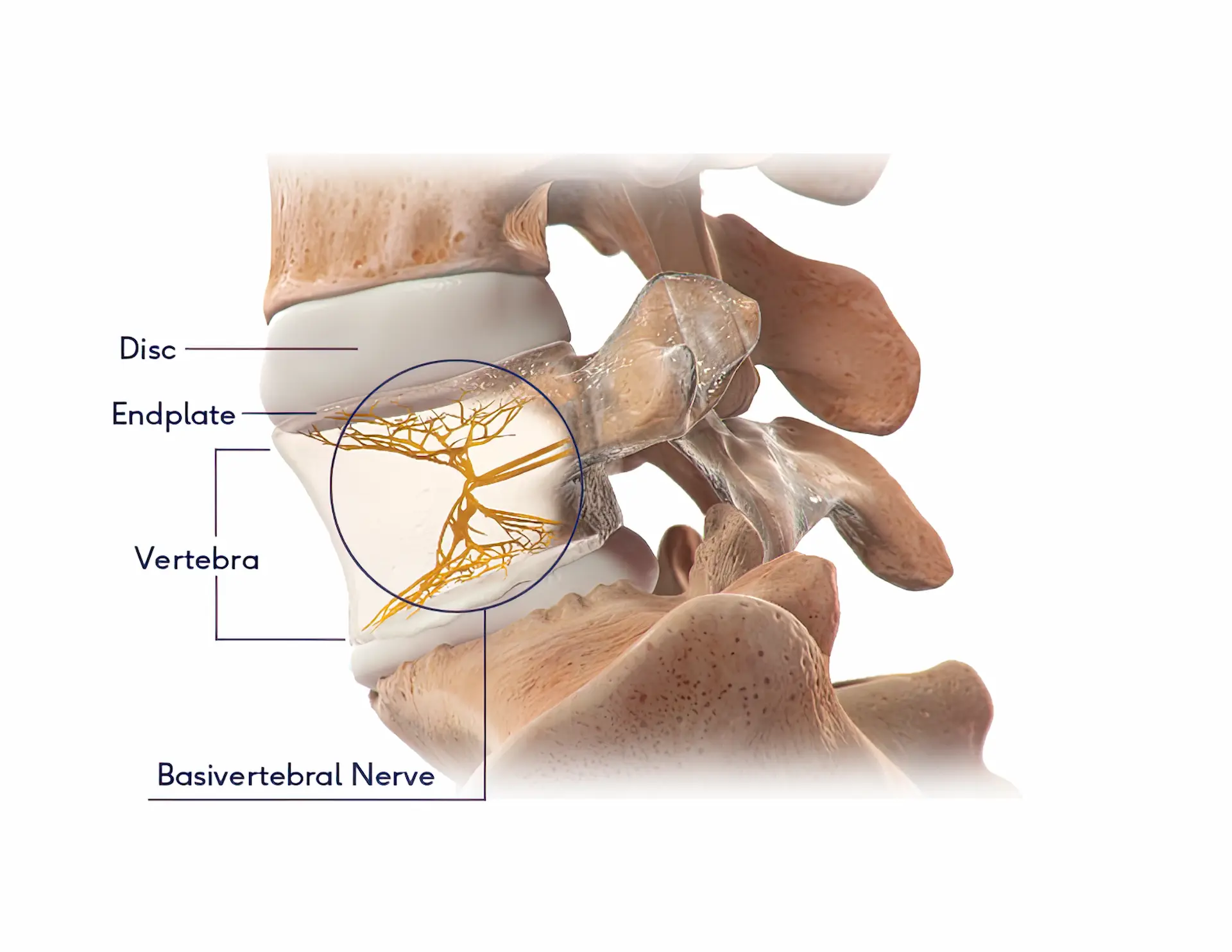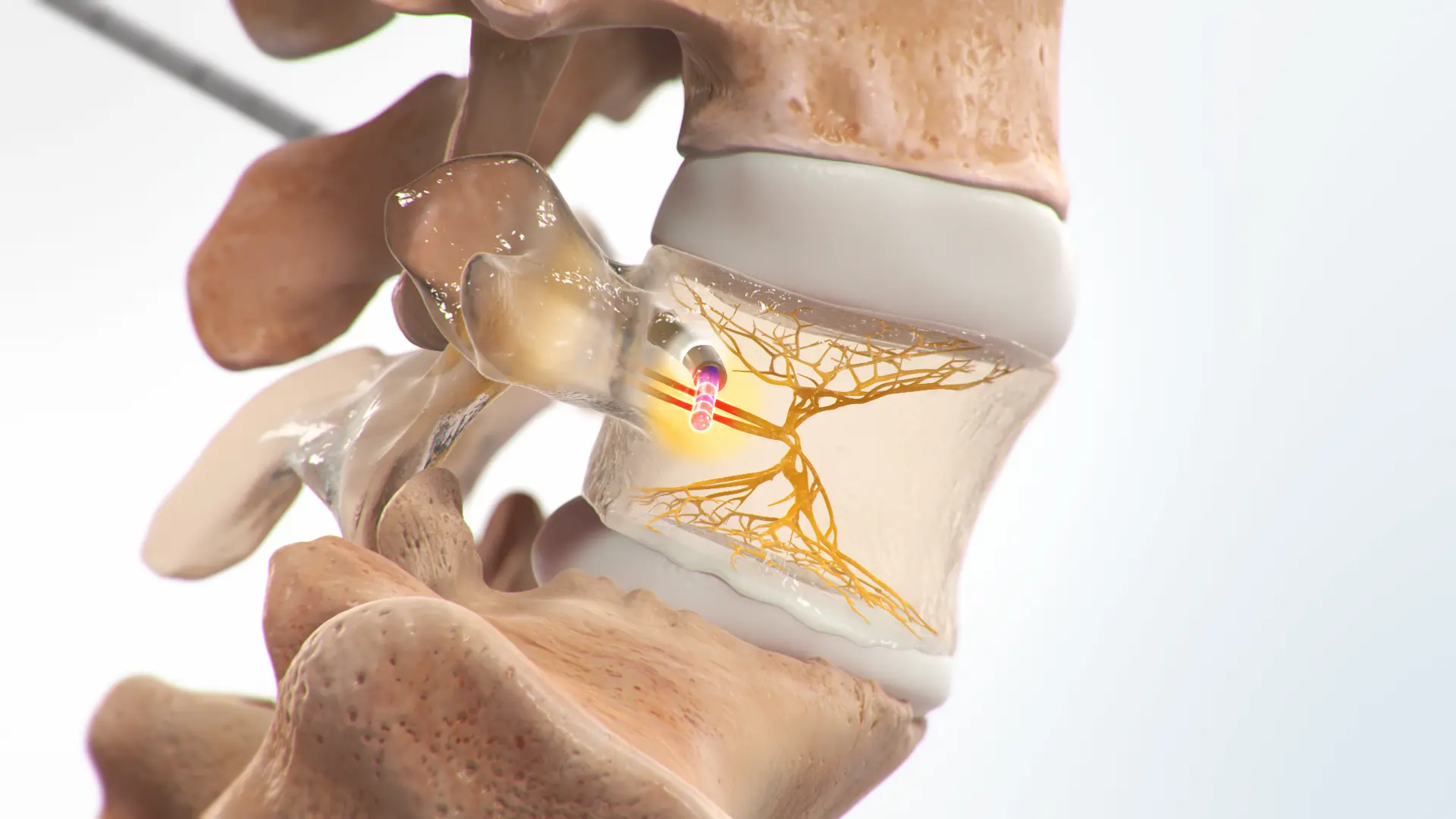Intracept Procedure
What is an Intracept Procedure?
The Intracept Procedure is an ultra-minimally invasive, outpatient procedure for patients with chronic low back pain. It is the only procedure specifically designed to target the basivertebral nerve, which is a nerve that runs through the center of the vertebrae in the low back. The basivertebral nerve can be irritated or damaged by age, degeneration, or injury, leading to chronic pain. The procedure is performed through less than a ¼-inch incision preserving low back muscles.
The Intracept Procedure uses radiofrequency energy to heat the basivertebral nerve, which reduces its ability to transmit pain signals to the brain. The procedure is performed under sedation and takes about an hour to complete.

Who is a candidate for the Intracept Procedure?
The Intracept Procedure is indicated for patients who have:
- Chronic low back pain for at least 6 months
- Tried conservative treatments, such as physical therapy and medication, without success
- Have MRI findings that suggest the basivertebral nerve is involved in their pain
- Degenerative disc disease (DDD) – is a common condition that affects the discs in the spine. As we age, the discs naturally wear and tear, which can lead to pain, inflammation, and stiffness. DDD can occur in any part of the spine, but it is most common in the lower back.
- Vertebrogenic low back pain – is pain that originates from the vertebrae or discs in the spine. It is the most common type of low back pain, and it can be caused by a variety of factors, including DDD, spinal stenosis, and spondylolisthesis.
Do I need an Intracept Procedure?
To verify if a patient is suffering from vertebrogenic pain and need an Intracept Procedure, doctors utilize MRI imaging to identify specific alterations associated with endplate degeneration and inflammation, known as Modic Type 1 or 2 changes.
The following conditions must be met for consideration for the Intracept Procedure:
- You’ve been experiencing persistent lower back pain for a minimum of six months.
- You’ve attempted various conservative treatments such as chiropractic care, yoga, medication, injections, and physical therapy, but these have not yielded saexhibitstisfactory outcomes.
- Your MRI characteristics in line with Modic changes, suggesting inflammation caused by damage at the vertebral endplates.
- If these conditions apply to you, you may be a suitable candidate for the Intracept Procedure. Nonetheless, it’s crucial to have a discussion with your healthcare provider about your symptoms and potential treatment options.
How is the Intracept Procedure performed?

The Intracept Procedure is performed under sedation and takes about an hour to complete. The patient is positioned on their stomach on an X-ray table. The physician uses a small needle to inject a local anesthetic into the skin and muscle at the back of the spine. A thin, flexible tube is then inserted through the needle and guided to the basivertebral nerve using X-ray imaging.
Once the tube is in place, a small radiofrequency probe is inserted through the tube and positioned at the tip of the basivertebral nerve. The radiofrequency probe is then heated, which causes the nerve to denervate, or die. This process is repeated on each basivertebral nerve that is causing pain.
The Intracept procedure is performed in the following steps:
- Access the pedicle. The surgeon makes a small incision in the back and inserts a needle into the pedicle, which is a hollow tube that connects the vertebra to the pelvis.
- Create the channel. The surgeon inserts a thin tube through the needle and into the pedicle. This tube creates a channel to the trunk of the BVN.
- Place the RF probe. The surgeon inserts a radiofrequency probe through the tube and into the trunk of the BVN.
- Ablate the BVN. The surgeon delivers radiofrequency energy to the probe, which heats up and ablates the BVN.
Once the BVN is ablated, it can no longer send pain signals to the brain. The patient should start to experience pain relief within a few weeks of the procedure.
What are the risks of the Intracept Procedure?
The Intracept Procedure is typically safe and well-received minimally invasive surgery, but like any surgery, there are some potential risks and complications associated with it. These risks include:
- Infection: There is a small risk of infection at the incision site.
- Bleeding: There is a small risk of bleeding during or after the procedure.
- Nerve injury: There is a small risk of nerve injury during the procedure. This could cause numbness, weakness, or pain in the leg or foot.
- Allergic reaction: There is a small risk of an allergic reaction to the anesthesia or other medications used during the procedure.
- Temporary pain at the site of treatment
What are the benefits of the Intracept Procedureants?
The Intracept Procedure has several benefits over other treatments for chronic low back pain, including:
- Minimally invasive: The Intracept Procedure is performed through a small incision in the back, which means there is minimal scarring and risk involved.
- Long-term pain relief: Clinical studies have shown that the Intracept Procedure can provide long-term pain relief, with many patients experiencing at least 5 years of sustained pain relief.
- Effective results in pain reduction: Many patients experience significant improvements in reducing their pain symptoms after the Intracept Procedure.
- Short recovery time: The Intracept Procedure is an outpatient procedure, and most patients are able to return home the same day. Most patients resume their normal activities within a few days to a week.
- No implants: The Intracept Procedure does not require the placement of any implants, which eliminates the risk of complications associated with implants, such as infection and loosening.
- Preserves range of motion: The Intracept Procedure does not affect the range of motion in the spine.
What to expect after the Intracept Procedure?
Patients typically go home the same day as the Intracept Procedure. They may experience some soreness and swelling at the treatment site for a few days. Most patients can return to their normal activities within a week.
The Intracept Procedure is a safe and effective treatment for chronic low back pain. It can provide long-term pain relief and improve function for patients who have failed to respond to conservative treatments.
Additional information
The Intracept Procedure is approved by the US Food and Drug Administration (FDA) for the treatment of chronic low back pain. It is also covered by most major insurance companies.
Choose The Right Doctor Is Important!
PaloVerde Pain Specialists is the best choice for the Intracept procedure in Peoria, AZ for several reasons:
- Expertise: Dr. Adam Kramer, the founder and medical director of PaloVerde Pain Specialists, is a double board-certified pain management physician with extensive experience in performing the Intracept procedure.
- Success rates: PaloVerde Pain Specialists has a high success rate with the Intracept procedure, with many patients experiencing significant pain relief and improved quality of life.
- Patient-centered care: PaloVerde Pain Specialists is committed to providing compassionate and individualized care to each patient. They take the time to understand each patient’s unique needs and develop a personalized treatment plan.
- Comprehensive services: PaloVerde Pain Specialists offers a wide range of pain management services, including the Diabetic Neuropathy, epidural steroid injections, facet joint injections, medial branch blocks, medication management, occipital nerve blocks, radiofrequency ablation, spinal cord stimulation, and trigger point injections.
- Convenient location: PaloVerde Pain Specialists is conveniently located in Peoria, AZ, making it easy for patients to access their services.
In addition to these reasons, PaloVerde Pain Specialists is also highly rated by patients. On Google, PaloVerde Pain Specialists has a rating of 4.9 out of 5 stars, with patients praising Dr. Kramer’s expertise, compassion, and bedside manner.